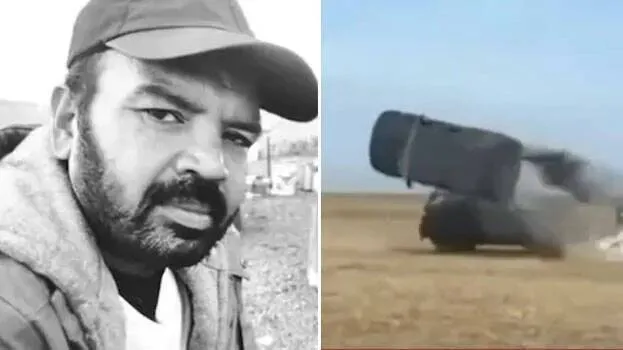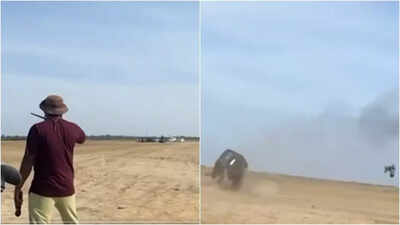The Indian film industry is reeling from the tragic loss of S Mohanraj, a veteran stunt artist, who died on July 13, 2025, during the shooting of the Tamil film Vettuvam in Nagapattinam district, Tamil Nadu. Mohanraj, 52, was performing a high-risk car stunt when the accident occurred, sending shockwaves through the stunt community and raising urgent questions about safety standards on film sets. His death has sparked widespread mourning and renewed debate about the risks faced by stunt professionals, the unsung heroes of Indian cinema.
The aftermath of S Mohanraj’s passing has sparked a wave of introspection within the Indian film fraternity. Directors, producers, and production houses are now under increasing pressure to reevaluate their approach to on-set safety, especially during high-risk action sequences. Many insiders have admitted that, despite technological advancements and the availability of specialized safety gear, budget constraints and tight shooting schedules often lead to compromises.
This tragedy has reignited debates about the need for regulatory oversight, with some calling for the establishment of an independent safety board that can audit and certify film sets before dangerous stunts are performed. Such measures, supporters argue, would not only protect artists but also enhance the overall professionalism and reputation of Indian cinema on the global stage.
Family members of S Mohanraj, still reeling from the shock, have spoken out about the personal and financial toll such accidents inflict. Mohanraj was the primary breadwinner for his family, and his sudden demise has left them in a precarious situation. His wife and children have received an outpouring of support from the local community and the film fraternity, but questions remain about the adequacy of compensation and long-term security for families of stunt artists who lose their lives in the line of duty. Many are now demanding that every production house set up a mandatory insurance fund for stunt professionals, ensuring that their families are not left destitute in the event of a tragedy.
The Incident: A Routine Stunt Turns Fatal
S Mohanraj, a respected figure in the stunt fraternity, was hired for Vettuvam, a film produced by director Pa Ranjith’s Neelam Studios. The shoot was underway in Vilunthamavadi village near Velankanni since July 10. On the fateful Sunday, Mohanraj was executing a car-toppling sequence—a staple in action films but one of the most dangerous stunts in the industry. According to eyewitnesses and viral video footage, the SUV flipped violently mid-air during the sequence. Mohanraj, who was driving, slipped and fell from the vehicle. Immediately after the fall, he complained of severe chest pain, suspected to be a heart attack, and collapsed on set.
Crew members rushed to his aid, pulling him from the vehicle and calling for emergency medical assistance. He was taken to the Nagapattinam Government Medical College Hospital, but doctors declared him dead on arrival. The Keelaiyur police have registered a case and are investigating the circumstances leading to the accident, while the film’s production has been temporarily halted as a mark of respect.
The Unsung Heroes: Stunt Artists and Their Daily Risks
Mohanraj’s death has cast a harsh spotlight on the often-overlooked world of stunt professionals in Indian cinema. These artists routinely put their lives on the line to create the thrilling action sequences audiences love, yet they remain largely unrecognized and underprotected. Car stunts, in particular, are considered among the most perilous, requiring a combination of technical skill, physical fitness, and nerves of steel. Even with safety protocols in place, the unpredictable nature of such stunts means that a single miscalculation can have fatal consequences.
Veteran stunt directors and artists have spoken out in the wake of the tragedy, emphasizing the inherent dangers of their craft. Many note that despite advances in technology and safety equipment, the risk remains high, especially for sequences involving vehicles. Stunt artist associations, which have about 600 members, are calling for better insurance coverage, improved safety measures, and mandatory rehearsals with advanced medical support on set.
Mourning and Solidarity: The Film Industry Responds
The news of Mohanraj’s passing has elicited an outpouring of grief from the Tamil film community and beyond. Prominent actors, directors, and fellow stunt professionals have paid tribute to his courage and dedication. Actor Vishal and renowned stunt choreographer Stunt Silva expressed their condolences on social media, highlighting Mohanraj’s reputation as one of the best car stunt performers in the industry. Silva described him as “one of our great car jumping stunt artists,” and lamented the loss to the fraternity.
Stuntmen who have worked with Mohanraj recalled his professionalism and camaraderie, remembering him as a brother and mentor. Many in the community have shared personal stories of injuries and close calls, underscoring the daily dangers faced by those in their profession. The tragedy has also prompted calls for greater recognition of stunt artists’ contributions, both in terms of awards and financial security for their families.

The Dark Side of Glamour: Stunt Work and Socioeconomic Realities
Mohanraj’s death has reignited debate about the socioeconomic pressures that drive individuals to take up such risky jobs. Many stunt artists come from modest backgrounds, drawn by the promise of steady work and the excitement of the film industry. However, the financial rewards are often meager compared to the risks involved. Unlike actors and directors, stunt professionals rarely receive public acclaim or substantial compensation, and their families are left vulnerable in the event of injury or death.
Industry veterans have pointed out that while technological advances have made some stunts safer, the pressure to deliver ever more spectacular action sequences can lead to corners being cut. The lack of formal training and certification for many stunt artists further compounds the risks. There is a growing consensus that the industry must do more to provide training, safety nets, and long-term support for these essential workers.
Calls for Reform: Safety, Recognition, and the Way Forward
The tragic incident on the set of Vettuvam has prompted renewed calls for reform within the Indian film industry. Stunt artist associations are demanding stricter enforcement of safety protocols, including comprehensive rehearsals, better equipment, and the presence of medical teams during high-risk shoots. There are also appeals for mandatory insurance policies for all stunt professionals and their families.
Beyond safety, there is a push for greater recognition of stunt artists’ contributions. Industry leaders and fans alike are urging film awards and organizations to create dedicated categories for stunt coordination and performance. The hope is that increased visibility and acknowledgment will lead to better working conditions and a stronger sense of solidarity within the industry.
Remembering S Mohanraj: A Life of Courage and Dedication
Born and raised in Kanchipuram, Tamil Nadu, S Mohanraj was known for his fearless approach to stunt work and his commitment to his craft. Over a career spanning decades, he contributed to numerous Tamil and South Indian films, earning the respect of colleagues and filmmakers alike. His passing is a stark reminder of the invisible risks borne by those who bring cinematic action to life.
As the film community mourns his loss, there is a collective resolve to honor his memory by advocating for safer working conditions and greater respect for stunt professionals. Mohanraj’s legacy will live on in the countless breathtaking moments he helped create on screen—and in the ongoing fight for justice and recognition for his peers.

Conclusion
The death of S Mohanraj on the set of Vettuvam has sent shockwaves through Indian cinema, exposing the dangerous realities faced by stunt artists and the urgent need for reform. As tributes pour in and investigations continue, the industry is confronted with hard questions about safety, compensation, and the value placed on those who risk everything for the sake of entertainment. Mohanraj’s sacrifice must not be in vain; it should serve as a catalyst for lasting change, ensuring that the unsung heroes of Indian cinema are finally given the protection, recognition, and dignity they deserve.
The tragedy has also brought to light the mental and emotional challenges faced by stunt artists. The constant exposure to danger, the pressure to deliver flawless performances, and the lack of recognition can take a significant toll on their psychological well-being. Fellow stunt artists have shared stories of anxiety, sleepless nights, and the ever-present fear of injury or worse. There is a growing consensus that, in addition to physical safety, mental health support must become an integral part of the industry’s approach to caring for its action professionals. Workshops, counseling, and peer support groups are some of the initiatives being discussed to address these often-ignored aspects of their lives.
In the days following Mohanraj’s death, social media has been flooded with tributes and calls for change. Hashtags demanding justice for stunt artists and greater safety on film sets have trended across platforms, reflecting public outrage and empathy. Fans have shared clips of Mohanraj’s daring stunts from various films, celebrating his courage and skill while mourning his loss. The incident has also prompted a broader conversation about the value placed on behind-the-scenes talent in the film industry, with many arguing that the glamour of cinema should not come at the cost of human life and dignity.
Younger stunt artists, inspired by Mohanraj’s career but shaken by his untimely death, are now advocating for more structured training and certification programs. They argue that formal education in stunt work, combined with rigorous safety drills, can reduce the risk of accidents and elevate the status of their profession. Some have proposed collaborations with international stunt academies to bring global best practices to India, ensuring that local talent is equipped with the latest knowledge and techniques. These voices are gaining traction, with industry veterans lending their support to the cause.
As the investigation into the accident continues, there is hope that the lessons learned from this tragedy will lead to concrete reforms. Film unions and artist associations are preparing to submit recommendations to government bodies and industry stakeholders, urging swift action to protect stunt professionals. The legacy of S Mohanraj, many believe, should not be limited to his on-screen heroics but should serve as a catalyst for a safer, more just environment for all those who risk their lives to create cinematic magic. The coming weeks will be crucial in determining whether this moment of grief can be transformed into lasting, positive change for the Indian film industry.
Follow: vettuvam
Also Read: Tragedy at Southend: 4 Lives Lost in Fiery Airport Crash—A Nation in Shock

